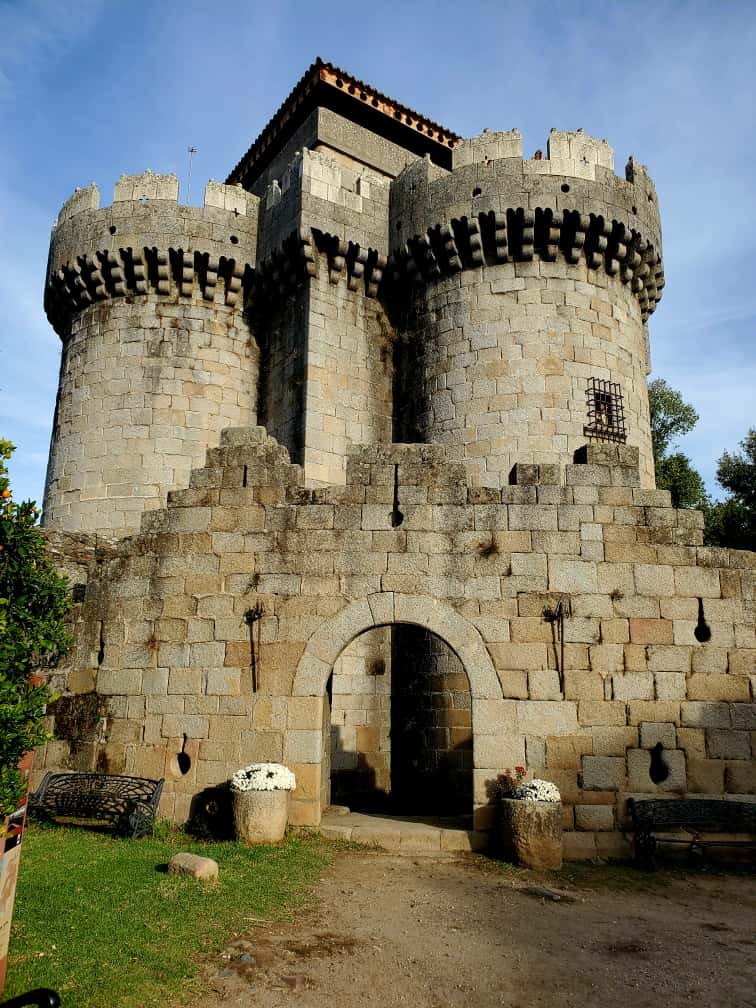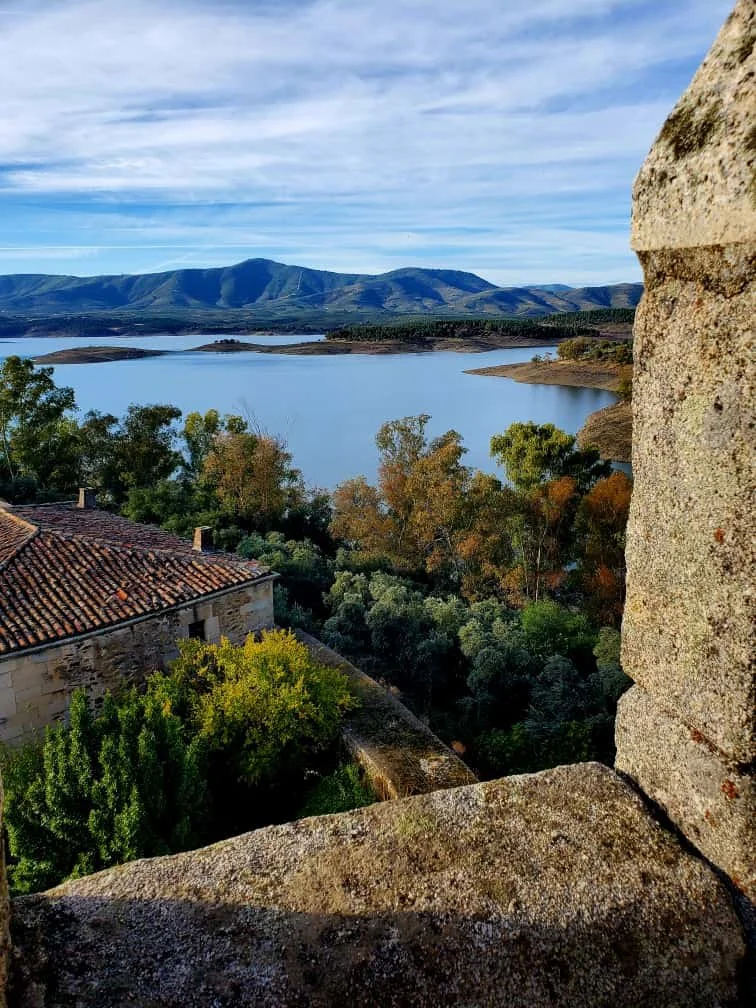Click here to read the previous post, Adjusting to Life in Spain: Weekend Trip to Jarandilla de la Vera (Summer)
My Spanish boyfriend (I don’t need to say this every time, but this Canadian gal just likes the way it sounds!) Alberto and I returned to Jarandilla de la Vera for another weekend getaway.
Jarandilla, as you may recall from my last blog post, is a small town in Cáceres province, Extremadura, Spain which has a population of about 2,845 and takes about 2.5 hours to get there by car.
This time, it was in the fall, so we didn’t swim in the natural rivers. So what did we do? Besides drinking plenty of vermouth, you mean?
The Arrival of Emperor Carlos V
Yes, Emperor Carlos V (or, in English, Charles the Fifth) himself arrived in Jarandilla de la Vera!
Or, to pay respect to his full title: Carlos V, Holy Roman Emperor and Archduke of Austria (1519-1556), Carlos I, King of Spain (1516-1556), and King of Sicily and Naples (1516-1554), and Carlos II, Lord of the Netherlands and titular Duke of Burgundy (1506-1555).
The odd thing is, Spaniards refer to him as Carlos V even though that was not his title as King of Spain. When I asked my Spanish boyfriend (hehe, ok, ok, enough), he explained that when Carlos inherited the Spanish crown in 1516, no Spanish king had ever been named Carlos before. So in Spain he became Carlos I (the first “Carlos” to rule Spain). In 1519 when he was elected Holy Roman Emperor, four previous emperors had been named Carlos/Karl/Charles, so he became the fifth: Carlos V.
But Spaniards call him “Carlos V” even though he was Carlos I of Spain because his imperial title was more historically significant, and it’s how he is most widely known in Europe and in world history.
Ok, back to reality.
So obviously the actual emperor did not show up in Jarandilla in November 2025. Just some some dude dressed like him for this festival. When A and I stepped out of the house to go for a walk, we found ourselves swept up in a throng – yes, a throng, I tell you! – of people parading through the streets, many of whom were wearing costumes, playing instruments and holding torches (burning sticks, not flashlights, for my British readers).
When Carlos I of Spain and V of the Holy Roman Empire abdicated in 1556, he came to Jarandilla where he lived for several months in the castle of Jarandilla—now the Parador de Jarandilla, a medieval castle turned hotel. From there, he walked to the nearby Monasterio de San Jerónimo de Yuste (Monastery of Yuste) – a 2.5-hour stroll, probably longer if you’re wearing heavy royal garments – a place he had admired years earlier for its beauty and serenity.
He didn’t become a monk but, worn down by the strain of ruling a giant empire in constant conflict and also gout, he spent his final two years there in seclusion until his death in 1558.
As with most small towns, Alberto and I bumped into some people he knew, and the six of us joined the parade to a small plaza. There, we watched the “emperor” and his entourage give a final turn of the plaza, a short symphony performed by schoolchildren, and five exact replicas of the same traditional dance until A and I couldn’t stop laughing. (Announcer: “And now a completely different dance with absolutely different music!” Cue: the same music and the same dance.)
Granadilla: An Ancient Medieval Village
The next day, Alberto and I took a little day trip to visit the ruins of a medieval village, Granadilla. It was a lovely 1.5-hour drive through the country.
Granadilla is a preserved medieval “ghost village” with cobblestone streets, an intact defensive wall, and a 15th-century castle overlooking the water. Founded in the 9th century by Muslims, Granadilla was built in such a location that the townspeople could keep a careful eye on the ancient trade and travel corridor known as the Ruta de la Plata.
Source: BBC
Then later, in the 1950s, when Franco was in power, Spain started building dams as an economy booster, figured that Granadilla was in the floodplain, and ordered the whole town (1,000 people) to evacuate. But even though the town never did flood, residents were never allowed to come back to their homes. And after all these years, the government still maintains the flooding decree signed by Franco.
But the deserted town is open to visitors during regular business hours. A little bittersweet, I suppose, but still worth visiting. We entered through a gate in the stone wall, which felt like going back in time.
We explored the castle first. Although the original medieval town was founded by Muslims in the 9th century, the castle was built in the 15th century by the Álvarez de Toledo family, rich nobles who controlled the area after the Christian reconquest.
Though it looks fairly small on the outside (for a castle), it’s surprising large on the inside, with rooms leading to other rooms leading to other rooms.
For example, we suddenly found ourselves in a very small room with one window and two built-in stone seats with…a hole in each one. A quickly deduced that it was ye olde fashioned toilet. Hole = pre-flush mechanism. But two toilets right next to each other? You must really miss your lover if you can’t even defecate without leaving their side. Also, I don’t envy the castle servant who happened to be working below.
So we immediately sat down to give it a try.
KIdding. We wandered around the castle, looking out the window at the front gate…
And then at the view of the river from the top of the castle…
We ambled through the town for a short time before finding an entrance to the defensive wall (muralla) and climbed the stairs. As the sun was setting, we strolled along the wall that encircled and overlooked the whole town – old, deserted buildings and walls without roofs – on one side and the river and landscape on the other side.
We came across a little nook in the wall with a built-in stone table and two stone benches (without holes, don’t worry) and thought, what the hell! It’s rest time. So we sat down and had a little mini picnic which, I’m learning, Spaniards – or at least A – always brings with them: bread, chorizo and vermouth. Much to the envy of the occasional passersby.
Balneario Baños de Montemayor
On our final day, we headed out for another (half) day trip: to the Baños de Montemayor Spa, about an hour and a quarter from Jarandilla.
For this, A had made an appointment for two in the mineral pool. Our appointment didn’t include massages or facials or any other health or beauty treatments because they weren’t available, but this is a full-treatment spa.
One thing I noticed was different was that the changing room was co-ed. And not only that, but many of the change rooms were large enough to accommodate two people (with walls and doors for privacy). So after we undressed and got into our bathing suits, put on the robes and bathing caps they’d given us and placed our belongings into a locker, we walked through the co-ed change room, across the main lobby and into the co-ed pre-pool showers.
But once we entered the pool area, I was awestruck.
Source: Balneario Baños de Montemayor
The thermal springs at Baños de Montemayor date back to Roman times (1st–4th centuries AD). Romans used the sulphur-rich springs for bathing and healing – so you are literally bathing in a place where Romans once bathed. The site lies along the ancient Roman route known as the Vía de la Plata, which contributed to its therapeutic significance. Hot springs along major Roman roads became valuable for travelers due to their medicinal and recreational properties.
Source: Balneario Baños de Montemayor
And, no, this is not what the mineral baths look like today!
The water for this pool is classified as sulphated (sulfur-rich), sodi-caldic and oligometallic, and these properties make it suitable for treatments of rheumatism, arthrosis, respiratory issues, and skin toning. At the 1900 Universal Exposition in Paris, these mineral-medicinal waters were awarded Silver and Bronze medals.
So we spent almost an hour casually swimming, floating, standing under a power spray to massage sore muscles, and just sort of hanging out in the warm pool in the warmly lit atmosphere.
There was a small, ICE COLD pool in which I submerged myself, followed by teeth-chattering curses under my breath as I leaped back into the regular pool. The water was so cold I immediately got a headache and it took about five minutes in the warm pool with A vigorously rubbing my arms and embracing me with his body heat. And then about twenty minutes later I did it again.
Have I lost my mind? you may be asking. Probably, but that’s besides the point. Cold plunging can help reduce inflammation and muscle soreness, as well as restore balance to the nervous system and improve cognitive function and mood.
We left the spa refreshed and relaxed, and drove back to Madrid from there. We stopped along the way for dinner and a good leg stretching in the crisp evening air, and made it back home in one, contented, piece.
Click here to read the next post, Adjusting to Life in Spain: Weekend Trip to Jarandilla de la Vera (Los Escobazos)
Note: All photos taken or created (using DALL-E) by Selena Templeton, unless otherwise noted.
If you enjoyed reading this travel blog, check out some of my other adventures:
Adjusting to Life in Spain: Dating in My Non-Native Language
Adjusting to Life in Spain: Using the Spanish Healthcare System
Adjusting to Life in Spain: Damn, I Can’t Find My Favorite Products Here!
From Fiesta Invites to Flamenco Nights: My Adventure in Spain
My Road Trip to the Four Corners: Utah, Colorado, New Mexico, Arizona















